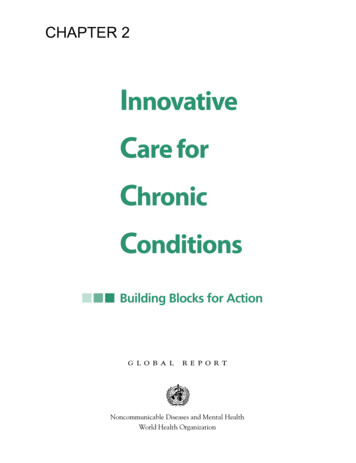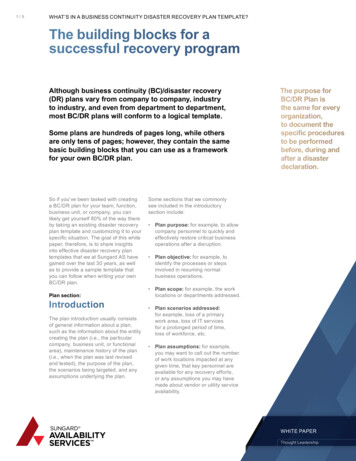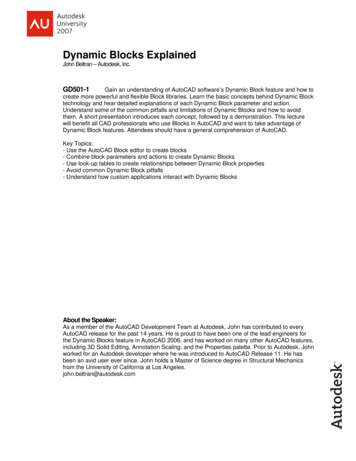
Transcription
CHAPTER 2InnovativeCare forChronicConditionsBuilding Blocks for Actionglobal reportNoncommunicable Diseases and Mental HealthWorld Health Organization
WHO Library Cataloging-in-Publication DataInnovative care for chronic conditions: building blocks for action: global report1. Chronic disease 2. Delivery of health care, Integrated 3. Long-term care 4. Public policy5. Consumer participation 6. Intersectoral cooperation 7. Evidence-based medicineI. World Health Organization. Health Care for Chronic Conditions Team.ISBN 92 4 159 017 3(NLM classification: WT 31)This publication is a reprint of material originally distributed as WHO/MNC/CCH/02.01 World Health Organization 2002All rights reserved. Publications of the World Health Organization can be obtained from Marketingand Dissemination, World Health Organization, 20 Avenue Appia, 1211 Geneva 27, Switzerland (tel: 41 22 791 2476; fax: 41 22 791 4857; email: bookorders@who.int). Requests for permission to reproduce or translate WHO publications – whether for sale or for noncommercial distribution – should beaddressed to Publications, at the above address (fax: 41 22 791 4806; email: permissions@who.int).The designations employed and the presentation of the material in this publication do not imply theexpression of any opinion whatsoever on the part of the World Health Organization concerning thelegal status of any country, territory, city or area or of its authorities, or concerning the delimitation ofits frontiers or boundaries. Dotted lines on maps represent approximate border lines for which theremay not yet be full agreement.The mention of specific companies or of certain manufacturers’ products does not imply that theyare endorsed or recommended by the World Health Organization in preference to others of a similarnature that are not mentioned. Errors and omissions excepted, the names of proprietary products aredistinguished by initial capital letters.The World Health Organization does not warrant that the information contained in this publication iscomplete and correct and shall not be liable for any damages incurred as a result of its use.
This report was produced under the direction of JoAnne Epping-Jordan, Health Care for ChronicConditions. It is the first key component of a three-pronged WHO strategy to improve the prevention and management of chronic conditions in health care systems. This strategy is overseen by Rafael Bengoa, Director, Management of Noncommunicable Diseases, and Derek Yach,Executive Director, Noncommunicable Diseases and Mental Health.The three WHO Health Care for Chronic Conditions projects related to this strategy are:Innovative Care for Chronic Conditions (managed by JoAnne Epping-Jordan)Improving Adherence (managed by Eduardo Sabaté)Primary Health Care for Chronic Conditions (managed by Rania Kawar)Technical input for this report was provided by the overall WHO chronic conditions team, as wellas by a range of other WHO staff members. Administrative support was provided by Elmira Adenova, Health Care for Chronic Conditions.Writing team: Sheri Pruitt (principal writer); Steve Annandale, JoAnne Epping-Jordan, JesúsM. Fernández Díaz, Mahmud Khan, Adnan Kisa, Joshua Klapow, Roberto Nuño Solinis, SrinathReddy, and Ed Wagner (supporting writers).Case Example Contributors: Shitaye Alemu, Fu Hua, David Green, Desiree Narvaez, Jean Penny,Masoud Pezeshkian, Prema Ramachandran, Pat Rutherford, and Judith SefiwaICCC Framework Meeting Design and Facilitation: Peter KeyGraphic Design, first edition: Laurence HeadGraphic Design, this edition: Health and Development Networks — www.hdnet.orgWHO is exceedingly grateful to the many policy-makers, health care leaders, and other expertswho gave their time to provide comments and suggestions on this report at different stages.The production of this report was made possible through the generous financial support of the governments of Finland, Netherlands, Norway, and Switzerland.
Current Systems Are NotDesigned for Chronic Problems“Health care system” has been defined as that system which encompasses all theactivities whose primary purpose is to promote, restore, or maintain health (WorldCurrentConditions:Systems AreNot1.2.ChronicTheHealthDesignedfor ChronicProblemsCareChallengeof the 21stCenturyHealth Report 2000). Thus, “systems” are remarkably expansive and include patients andtheir families, health care workers and caregivers within organizations and in the community, and the health policy environment in which all health related activities occur.A Brief History of Health Care SystemsHistorically, acute problems, such as certain infectious diseases, were the principalconcern for health care systems. Advances in biomedical science and public healthmeasures over the past century have limited the impact of many communicable diseases in most developed countries. And, while some infectious diseases continue to bea threat and an important consideration for health care systems in many developingcountries, these systems now must respond to an additional set of health problems.Because current health care systems developed in response to acute problems and theurgent needs of patients, they are designed to address pressing concerns. For example, testing, diagnosing, relieving symptoms, and expecting cure are hallmarks of contemporaryhealth care. Moreover, these functions fit the needs of patients experiencing acute andepisodic health problems. However, a notable disparity occurs when applying the acutecare template to patients who have chronic problems. Health care for chronic conditionsinherently is different from health care for acute problems, and in this regard, currenthealth care systems worldwide fall remarkably short. Health care systems have not keptpace with the decline in acute health problems and the increase in chronic conditions.29
When health problems are chronic, theacute care practice model doesn’t work.In fact, health care systems have not noticeably evolved beyond the conceptual approachused in diagnosing and treating acute conditions. The acute care paradigm is pervasive andnow permeates the thinking of decision-makers, health care workers, administrators, andpatients. The acute care model drives the organization of care throughout the world eventoday, even in the most economically developed countries.To address the rising rates of chronic conditions, an evolution in health care systems is imperative, and they have to advance beyond the acute care model. Acute care will always be necessary (even chronic conditions have acute episodes), but at the same time health care systemsmust embrace the concept of caring for long-term health problems. Patients, health care organizations, and decision-makers have to recognize the need to expand systems to include new concepts. Decision-makers are instrumental in facilitating a shift in thinking about health care.What are the Current Problems?Micro-, Meso-, and Macro-LevelsOne strategy to organize thinking about health care systems is to divide these complicatednetworks into strata or levels. Micro-, meso-, and macro-levels provide a reasonable frameworkand refer to the patient interaction level, the health care organization and community level,and the policy level, respectively. Each of these levels interacts with and dynamically influences the other two. For example, consider the levels as linked by interactive feedback loopsin which events at one level influence actions and events at another level, and so on. In thisscheme, patients respond to the system in which they receive care, and health care organizations and communities are responsive to policies that in turn influence patients. And, the feedback loops perpetuate. 30
CurrentConditions:Systems AreNot1.2.ChronicTheHealthDesignedfor ChronicProblemsCareChallengeof the 21stCenturyWhen micro-, meso- and macro-levels work effectively within themselves, and successfullyfunction in relation to each other, health care is efficient and effective; patients experiencebetter health. Dysfunction within and among the levels creates waste and ineffectiveness.Unfortunately, concerning health care for chronic conditions, dysfunction in the health caresystem is typical.Delineation between micro-, meso-, and macro- levels is not always clear. For example,when health care personnel are not prepared to manage chronic conditions because of training deficiencies, the problem could be considered a micro-level problem because it affectspatients. Training deficiencies could be considered a meso-level problem because it is theresponsibility of the health care organization to ensure providers have the expertise and toolsto care for patients. Alternatively, training could be considered a macro-level issue because apolicy decision could alter medical training curricula or continuing education requirementsto meet population demands.Micro-Level: Patient Interaction ProblemsWithin the micro-level of health care, problems are evident. Systems fail to recognize theextraordinary importance of patients’ behaviours and the value of quality interactions withhealth care workers in influencing the outcomes of health care. There is ample scientific evidence regarding efficacious strategies for the micro-level (e.g., interventions for changing patientbehaviours, techniques for increasing medication adherence, or methods for improving healthcare worker communication); however, this evidence is not integrated into daily clinical practice. Two common problems at the micro-level are the failure to empower patients to improvehealth outcomes and the lack of emphasis on quality interactions with health care personnel.Failure to Empower PatientsChronic health problems are enduring, necessitating a care strategy that reflects a protracted time frame and clarifies for patients their roles and responsibilities in managing theirhealth problems. Appropriate clinical care is necessary; however, it is not sufficient for optimal health outcomes. Patients have to make changes in their lifestyles, must develop newskills, and must learn to interact with health care organizations to successfully manage theirconditions. They no longer can be viewed as, nor see themselves as, passive recipients ofhealth care services.Patients have to participate in their care and health care personnel must support their efforts.In fact, there is substantial evidence from more than 400 published articles that interventionsdesigned to promote patients’ roles in the management of chronic conditions are associatedwith improved outcomes. What patients do for themselves on a daily basis (e.g., adhere tomedication regimens, exercise, eat properly, sleep regularly, interact with health care organizations, and cease tobacco use) influences their health far more than medical interventionsalone. Unfortunately, patient behaviour that could prevent many chronic conditions, andimprove their management once they occur, often is overlooked in current health care.Health care workers report awareness of the importance of patient behaviour, but they statethey are ill-prepared to offer behavioural interventions to improve patients’ self-management31
and adherence abilities. Health care workers also relate that they are too time-pressured toaddress the educational deficits and psychosocial needs of patients and families.Center for the Advancement of Health. Indexed Bibliography of Behavioral Interventions of Chronic Disease.Washington, DC, 1996.There is substantial evidence (from over 400 studies of selfmanagement) that programmes providing counselling,education, information feedback, and other supports to patientswith chronic conditions are associated with improved outcomes.Center for the Advancement of Health, 1996.Failure to Value Patient InteractionsIt becomes imperative that patients develop quality relationships with health care personneland that these relationships persist across time. Health care workers must ensure that patients haveadequate information and skills to manage their chronic conditions. For this to occur, patientsneed a context in which they can freely ask questions, and they need an environment that initiates and supports their self-management behaviours. The quality of communication betweenthe patient and the provider is known to affect health outcomes across a variety of chronic conditions, including cancer, diabetes, hypertension, headaches, and peptic ulcer disease.Unfortunately, health care systems have failed to create an environment that promotesquality interactions and partnerships with patients, and there is evidence that health careworkers do not collaborate with patients on a variety of topics. Self-management, medication adherence, functional abilities, knowledge, or personal responsibilities are rarely discussed in the clinical context.Including patients in decision making and treatment planningmakes the delivery of care for chronic conditions more effectiveand more efficient.Holman, H. & Lorig, K. Patients as partners in managing chronic disease. BMJ 2000; 320:526–527.Meso-Level: The Problems with the Health CareOrganization and its Links to the CommunityThe health care organization coordinates the delivery and evaluates the quality of the servicesprovided. The organization has a responsibility to unite health care personnel, provide them withthe expertise and tools they need to perform their roles in managing patients with chronic problems, and link to community resources. Below are some examples of problems at the meso-level.32
Failure to Organize Care for Chronic ConditionsHealth care organizations are designed to address acute problems. They use discrete, face-toface visits with health care workers whose purpose is to diagnose and treat a patient’s presentingcomplaint. There are obvious problems with the application of this typical visit format to chron
This report was produced under the direction of JoAnne Epping-Jordan, Health Care for Chronic Conditions. It is the first key component of a three-pronged WHO strategy to improve the pre- vention and management of chronic conditions in health care systems. This strategy is over-seen by Rafael Bengoa, Director, Management of Noncommunicable Diseases, and Derek Yach, Executive Director .











